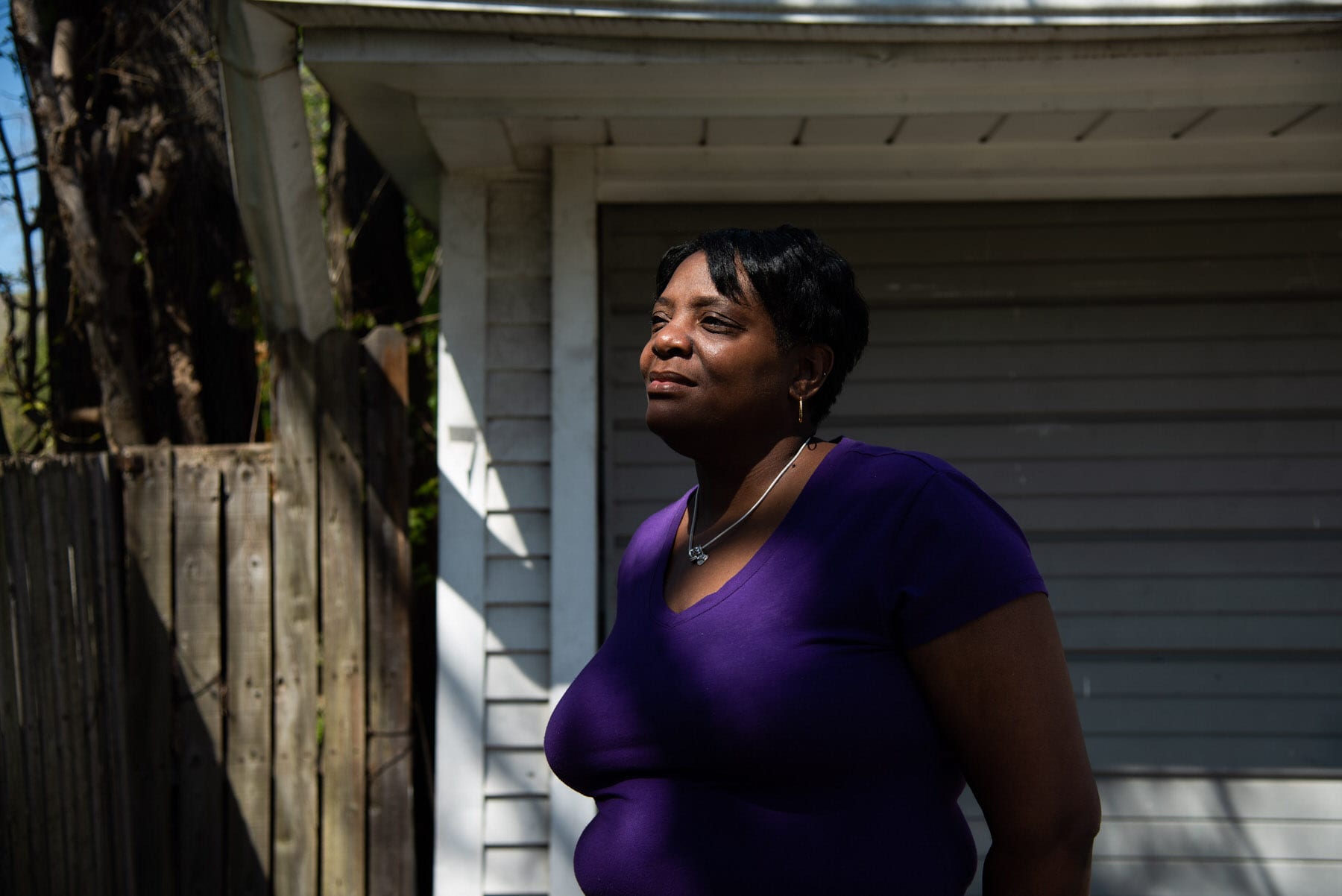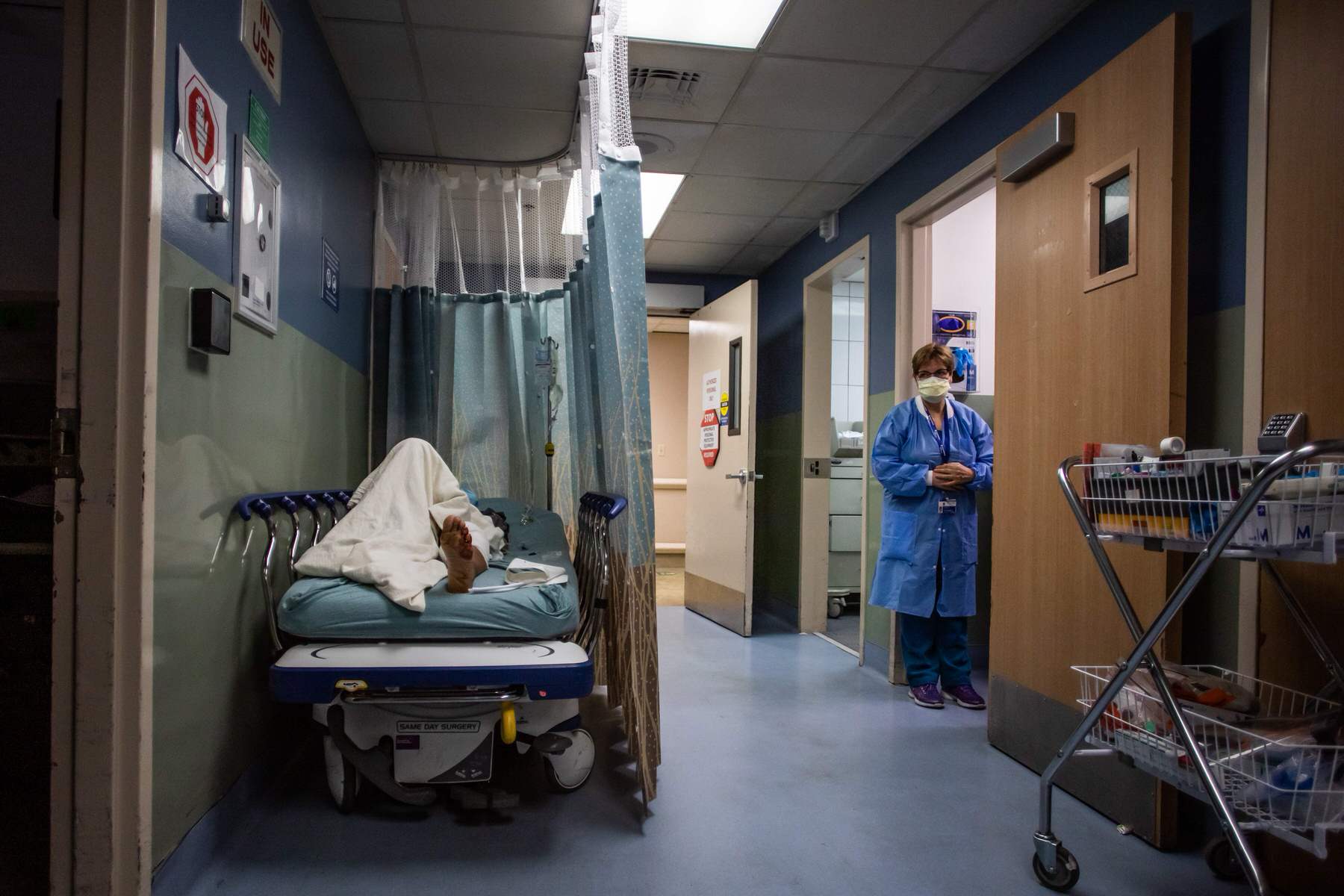We’re the only newsroom dedicated to writing about gender, politics and policy. Subscribe to our newsletter today.
Julie Conboy Russo had been a nurse for almost 40 years. She didn’t want to leave the field, but she didn’t feel she had a choice.
In November, COVID-19 cases were climbing nationally. Russo, who at the time worked in a long-term care facility in New York, had been lucky. She had never tested positive for the virus or brought it home to her immunocompromised husband. Case counts at her current workplace remained low.
Then the national surge arrived at her workplace. Within a week, she said, a COVID-19 cluster appeared at the facility. One resident fell ill and died days later.
Russo was terrified. Earlier that year, in a job at a different nursing facility, she had seen the damage the virus wrought. Working through the pandemic — seeing countless coworkers and patients die — is a memory she cannot shake. She doesn’t know if it will ever fully get better.
“They talk about PTSD — this is a form of it,” she said.
So when COVID arrived at the facility, she sought clearance to work from home. Her request was denied. Out of options, she resigned under duress, she said, which allowed her to qualify for unemployment. Now, Russo, 60, who had been working toward her doctorate in nursing, is devoting time to her dissertation. She hopes to return to work maybe a year from now, but isn’t sure if she’ll be able to find a job — she worries she is too old to be an attractive candidate.
“Maybe this is like a sign that this is where I needed to be. I’m healthy, I’m well, my husband is healthy and well,” Russo said. “Maybe this was a way to get away from it.”
The pandemic posed a Herculean challenge for the women-dominated health care industry, which is the largest single employment sector in America. Thousands of health care workers died. And still more carry immense psychological wounds in an industry where a third of workers say burnout is driving them out. In the past year, countless women — physicians, nurses and care workers — say the coronavirus crisis has driven them to leave the workforce or dramatically scale back their professional commitment.
Many don’t know if or when they will return.
Employment data shows that women lost or left more than 1.5 million net health care jobs in April 2020 alone. That represented 12 percent of all jobs held by women in health care. About 6 percent, or 196,000, of the jobs held by men were lost that month.
Even as jobs have begun to rebound, the recovery has been slower for women: They were still short 480,000 jobs as of this March, the most recent month for which data is available, compared with pre-pandemic levels. Men were short 28,000.
Industry experts say employment data is the tip of the iceberg.
Studies of the pandemic’s impact on women in medicine have shown that the past year has disrupted pipelines to leadership positions, tenure tracks, access to networking and collaborations, productivity and publications of academic research.
Experts worry that the pandemic only exacerbated the myriad ways in which the medical industry limits the professional advancement or equitable treatment of the women workers it relies on. If those problems go unaddressed, they say, the impact could be devastating, robbing women of one of their stablest employment pipelines, and undermining health care quality and outcomes for patients.
“You’re seeing these workers — they can't keep working, and many of them are women,” said Bianca Frogner, a health economist at the University of Washington who has studied this workforce. “We’re seeing a culmination that’s leading to this continued downward slope of women not gaining back employment.”
The onus of COVID caregiving fell squarely on the shoulders of health care workers who earned the least, and who had the most tenuous professional support structures in place — workers who happened to be women. As a result, burnout, already more prevalent among women health care workers than men, has skyrocketed.
Two decades ago, certified nursing assistant Kenya Blackburn would have been responsible for maybe five people a day at nursing homes in Michigan, enough to keep her busy but not overloaded, so she could properly care for patients.
At the height of the pandemic, she sprinted from patient to patient — as many as 30 in an eight-hour shift — to keep up with the workload.
Her care suffered. And so did her physical and mental health. Every missed interaction, every slip-up when she forgot to go back to a patient, felt like failure. The burdens she took home with her had never weighed heavier.
She’s thought more than once of leaving the industry. It’s all her coworkers talk about, she said. Her facility can scarcely keep trainees on before people quit to do something else — work at Amazon or a car plant or as a greeter at Walmart. As the industry overall has lost workers, cut costs and kept pay low — after 20 years, Blackburn only makes $15 an hour through a union contract — it has worn down people like her who are passionate about health care.
Things were difficult before the health crisis, “but it’s not getting better, it’s getting worse,” said Blackburn, 51. “We need the help, but the companies don’t want to pay for you to get more help or value you as a person. Instead they value you as a machine.”

Much of the job losses in the health care industry were concentrated in lower-paying, women-heavy professions such as home care and long-term care work. While men are back to pre-pandemic levels in almost every health care occupation, as of March 2021 there were still 10 percent fewer women working in nursing and residential care facilities compared to January 2020 and 3 percent fewer in home health care jobs, according to the Bureau of Labor Statistics.
Grueling schedules, low pay and pay disparities have been common in the health care industry for decades. Occupational segregation — which refers to the economic and social factors that push workers of a certain demographic into a particular field or profession — has, in health care, kept women in lower-paying industry jobs and specialties even among higher-paying positions.
Efforts to reach parity have stalled for years at every level, beginning with pay.
Nursing assistants, like Blackburn, are 82 percent women, earning a median wage of $14.82 an hour. Women represent 90 percent of home health aides, earning a median wage of $13.02 an hour, according to BLS data. Surgeons — of which nearly three-quarters are men — earn an average annual salary of more than $250,000 a year (BLS doesn’t list their median hourly pay because it is in excess of $100).
Doctors are closer to parity between men and women, with men representing 60 percent of the workforce. But women are still more likely to be in lower-paying specialties including pediatrics, family medicine and gynecology, and more likely to be junior physicians — the people who were called in when coronavirus cases surged, said Diana Lautenberger, the head of the gender equity lab at the Association of American Medical Colleges (AAMC).
In the past few years, women exceeded men as the largest share of medical school students at just over 50 percent. The pandemic has inspired an 18 percent surge in medical school applications — a shift that could help drive parity. But studies have found that following the completion of their residencies, women are far more likely to leave medicine because of burnout, harassment and pay inequities. As many as 40 percent of women doctors leave their jobs or move part-time within six years of completing their residency, according to one 2019 study by the University of Michigan.
Dr. Sasha Shillcutt — a cardiac anesthesiologist, professor at the University of Nebraska Medical Center and founder of Brave Enough, which helps women with reducing burnout in medicine — said the field of health care is still a reflection of the world it operated in decades ago when men were the overwhelming majority of physicians.
“The hierarchy of medicine has been built to accommodate men who for a century have not shared [the same caregiving] burdens. While the sheer number of women in medicine has increased, the hierarchy, and specifically the gender makeup of leadership in medicine, has not changed,” Shillcutt said. “Thus, neither have the work structures or work flexibility.”
Already, women health care professionals were questioning whether the industry could support them if it wasn’t offering access to crucial benefits like paid leave and child care or access to flexible schedules and support for continuing education or mentorship. The pandemic has only made that question more urgent.
Only about 25 percent of health care workers have access to paid family leave, and surveys of mothers in medicine have found that about four in five reported facing gender or maternal discrimination at work. A recent study of women in academic medicine that looked at U.S. medical school graduates from 1979 to to 2018 found that women were 23 percent less likely to be promoted to professor positions and 54 percent less likely to chair departments. It cited responsibilities with child care and elder care as one of the reasons women were held back from promotions.
It was the events of the past year that finally pushed Dr. Joanna Turner Bisgrove to leave her job of almost 14 years, a position as a part-time family medicine doctor in Wisconsin that had long failed to support her and other women at her hospital, she said.
For years, she had pushed for more representation and support for women physicians. Bisgrove was one of two women in her hospital system’s regional board and wanted to see more women in leadership. But many of those requests went unaddressed, she said. Then during the pandemic, doctors at her hospital were shut out of the support that some of the other health care workers received, such as flexibility for time off and help with child care.
The attitude toward the doctors, she said, was that they were expected to go without because their pay is significantly higher. But there was no acknowledgement of the dual roles many of them also perform, Bisgrove said.
“They completely ignored the women physicians who have the same issues as women on the health care staff,” Bisgrove said. “The cultural approaches are, particularly in corporate medicine: You're just a cog in the machine and you're there to earn money and make money for the organization.”
Bisgrove works part-time to focus on advocacy work centering equity and women in medicine and to take on leadership roles in the American Medical Association. She is moving to her hometown of Chicago to be closer to family and work in a program that gives her space to work on advocacy, public policy and finish her master’s degree in public health.
“I need a place that will support my advocacy and my work in health equity,” Bisgrove said. “When we've pointed it out, ‘Hey, this is a better way to approach things so you retain more physicians, particularly women physicians because they are growing part of the workforce and we are short doctors in Wisconsin, they just ignore me.”
But she said most of the physicians who also work part-time with her are doing it to address burnout or to better juggle family responsibilities.
There is limited research on how the pandemic affected women in medicine, but what exists points to child care as a major issue, said Dr. Yalda Jabbarpour, a primary care doctor who studies family medicine policy. Already, it was clear that burnout was higher for women in family medicine than men. When COVID-19 hit, she pivoted her research to figure out what that looked like in a global health emergency.
The survey she is working on — a qualitative analysis looking at about 100 family physicians, a specialty that already skews toward women — is still being analyzed. But the data already pointed out a clear theme, she said: During the pandemic, women left medicine to take on child care duties.
"'We’re definitely seeing that trend of 'schools closed, there was no day care, my employer wasn’t ready to support me with childcare options and so I think i’m going to have to leave,'" she said. "Medicine is one of those careers where when you leave, it’s really hard to go back."
"Of course family’s going to win out when there’s no child care," she added.
A survey of 152 academic medical institutions last fall by the Association of American Medical Colleges (AAMC) found that about half offered child care support — whether by helping doctors find care, subsidizing it or offering it on-site. In the pandemic, only the institutions that were already offering aid for child care bolstered those efforts.
“This tells us the chasm is widening between those institutions that are really seeing this as a critical employee issue … and those that have not,” said Lautenberger at AAMC.
If no adjustments are made, experts worry it could erode parity even further in one of the occupations that has the most opportunity to help women achieve higher pay in health care.
The data likely won’t reflect the pandemic’s impact for years. But it’s expected to show up later, Lautenberger said, as people make decisions about pursuing a health care profession, or instead opt for a job that allows for more flexibility and balance. The people most likely to seek that balance are women, who before their pandemic took on the majority of child care in their families and during the pandemic were willing to leave their jobs in order to perform care at home. It was a choice that men did not often confront.
“We’ve definitely seen that there is a demonstrated impact on women and their careers — we just don't know to what extent yet,” she said.
An exodus of women from health care could have ramifications not just for the industry, but for the nation at large, as the aging population grows and more Americans are expected to need some kind of nursing or home care. About three-fourths of the health care workforce is women, a reflection of their predominance in nursing and home care, specifically.
“These care and health care occupations are absolutely critical to supporting our entire country, and to supporting the people who are most vulnerable — who are sick, who are children and who are elderly, who need this serious and intensive medical care,” said Diana Boesch, a women’s economic policy analyst at the Center for American Progress, a liberal think tank. “If we don’t support the workers in those jobs, we will continue to face a crisis of care and a crisis of health care.”
Meanwhile, the loss of women physicians brings its own form of harm. A 2016 paper suggested that, in some contexts, having a woman doctor could actually be linked to better outcomes for patient health. And a wealth of evidence suggests that often patients prefer having a physician who is their same gender.
“It’s not that if I’m a woman, I don’t give a shit about guys — it's just that everybody has their own unconscious bias,” said Theresa Rohr-Kirchgraber, a professor of medicine at the University of Georgia and Augusta University, and past president of the American Medical Women’s Association. “If you don’t have folks who look like you at the table and in the office, you may not get the care that you need. It’s an advantage of having folks who are like you giving you your care.”
She worries that the past year built on the previous trends that might drive women out of medicine, or discourage them from pursuing a career in health care.
Zukie Seth, 24, has already felt those pressures acutely. She considers herself lucky: She’s young, unattached and without kids. But Seth, a critical care nurse in Washington, D.C., found herself struggling to hold on through the past year.
Typically, she said, nurses in her hospital care for two patients. But then as schools closed — and nurses who had children stayed home to care for them — more responsibility fell on younger nurses, like her. At the same time, the number of patients kept climbing. She found herself spending three to four hours at a time caring for patients with COVID complications, performing the bulk of patient care.
Last May, she said, the hospital suggested each nurse take on more patients. For the first time, Seth wondered if she could or should stay at her job, which is her first-ever full-time position. If she left, she knew it could mean permanent professional setbacks. She called her mother.
“I was like, ‘Mom, I can't make this work,’” Seth recalled. “It was starting to get bad, and we didn’t know how much worse it was going to get, and how long it was going to go on.”
Seth found it in herself to keep going. Still, the past year has made her think deeply about her choices going into nursing. She doesn’t regret it, she said, but “it’s been a big experience.”
Now, COVID cases have declined in the area, but workers are still tired and grieving, with little time to process. The burden is acute for nurses on the frontlines.
“The grief aspect is definitely just seeing so many patients go downhill so fast, and losing a large number of them,” she said. “The burnout has been coming from pocketing that grief and moving forward, because we don’t have time to stop and process it.”
President Joe Biden has touted plans that could ostensibly alleviate some of the challenges. He has called for improved access to child care, for reforms that would pay home care workers a $15 minimum wage, and that would create opportunities for advancement. Those are reforms that could help — especially with child care, which many women pointed to as a factor driving them out of work. (Biden’s proposal likely would not achieve universal child care, though.)
But none of those proposals has gotten buy-in from Republicans, and it’s unclear whether they will pass. Already, the U.S. Senate has shot down efforts to pass a $15 minimum wage. And even if enacted, they alone wouldn’t necessarily undo the effects of the past year, let alone the past decades.
Money is also just one part of it, many women said. There are also societal shifts to consider — respect for nurses and home care workers, and a culture that treats caregiving as work for both parents.
“It’s really important that our health care system revamps and thinks about what women in the workforce need,” Jabbarpour said. “The pandemic has brought that to light.”





